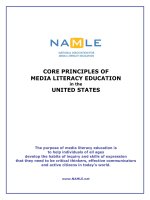The Visionary Director potx
Bạn đang xem bản rút gọn của tài liệu. Xem và tải ngay bản đầy đủ của tài liệu tại đây (4 MB, 70 trang )
e Vsioary Drec
Sample provided by iActiveLearning.com, all rights reserved.
ii The Visionary Director
Other Redleaf Press Books by Margie Carter and Deb Curtis
The Art of Awareness: How Observation Can Transform Your Teaching
Designs for Living and Learning: Transforming Early Childhood Environments
Learning Together with Young Children: A Curriculum Framework for Reflective Teachers
Reflecting Children’s Lives: A Handbook for Planning Child-Centered Curriculum
Spreading the News: Sharing the Stories of Early Childhood Education
Training Teachers: A Harvest of Theory and Practice
Sample provided by iActiveLearning.com, all rights reserved.
Vsioary
Drec
A Handbook for Dreaming,
Organizing, and Improvising
in Your Center
Second Edition
MARGIE CARTER
DEB CURTIS
e
Sample provided by iActiveLearning.com, all rights reserved.
Published by Redleaf Press
10 Yorkton Court
St. Paul, MN 55117
www.redleafpress.org
© 2010 by Margie Carter and Deb Curtis
All rights reserved. Unless otherwise noted on a specific page, no portion of this publication may be
reproduced or transmitted in any form or by any means, electronic or mechanical, including photo-
copying, recording, or capturing on any information storage and retrieval system, without permission
in writing from the publisher, except by a reviewer, who may quote brief passages in a critical article or
review to be printed in a magazine or newspaper, or electronically transmitted on radio, television, or
the Internet.
First edition published 1998. Second edition 2010
Cover design by Erin Kirk New
Interior typeset in Adobe Garamond Pro and Syntax and designed by Erin Kirk New
Interior illustrations by Claire Schipke, except those found on pages ii, v, 32, 51, 61, 110, 121, 218,
247, and 255, which are by Janice Porter
Developmental editing by Beth Wallace
Printed in the United States of America
16 15 14 13 12 11 10 09 1 2 3 4 5 6 7 8
Excerpts from “e Power of Purpose” by Susan Gross, Child Care Information Exchange 56 (July):
25–29, copyright © 1987 by Exchange Press, are reprinted with permission.
Excerpts from “Out of the Basement: Discovering the Value of Child Care Facilities” by Carl Sussmann,
Young Children 53 (1): 10–17, copyright © 1998 by Carl Sussman, are reprinted with permission.
Excerpts from Developmentally Appropriate Practice in “Real Life”: Stories of Teacher Practical Knowledge
by Carol Anne Wien, New York: Teachers College Press, Columbia University, copyright © 1995 by
Teachers College, Columbia University, are reprinted with permission.
Excerpt from Ordinary Ressurections: Children in the Years of Hope by Jonathan Kozol, New York: Crown
Publishers, copyright © 2000 by Jonathan Kozol, is reprinted with permission.
Excerpt from “When Someone Deeply Listens to You” by John Fox was originally published in Finding
What You Didn’t Lose: Expressing Your Truth and Creativity through Poem-Making, New York: Putnam,
copyright © 1995 by John Fox. Reprinted with permission.
Excerpts from Negotiating Standards in the Primary Classroom: e Teacher’s Dilemma by Carol Anne
Wien, New York: Teachers College Press, Columbia University, copyright © 2004 by Teachers College,
Columbia University, are reprinted with permission.
Excerpt from “Freedom’s Plow” was originally published in e Collected Poems of Langston Hughes by
Langston Hughes, New York: Random House, copyright © 1994 by the Estate of Langston Hughes.
Reprinted with permission.
Excerpts from Implementation of Continuity of Care in Infant/Toddler Programs by Alicia Tuesta,
Sausalito, CA: WestEd, copyright © 2007 by WestEd, are reprinted with permission.
Excerpt from “Catch the Fire” by Sonia Sanchez was originally published in Wounded in the House of a
Friend by Sonia Sanchez, Boston: Beacon Press, copyright © 1995 by Sonia Sanchez. Reprinted with
permission.
Excerpt from “Prayer for the Future” by Mir Yarfitz is reprinted with permission.
Library of Congress Cataloging-in-Publication Data
Carter, Margie.
e visionary director : a handbook for dreaming, organizing, and improvising in your center /
Margie Carter and Deb Curtis. — 2nd ed.
p. cm.
Previous edition cataloged under Curtis, Debbie.
Includes bibliographical references.
ISBN 978-1-60554-020-7
1. Day care centers—United States—Administration. 2. Early childhood education—United States.
I. Curtis, Debbie. II. Title.
HQ778.63.C87 2010
362.71’2068—dc22
2009020826
Printed on 30 percent postconsumer waste paper
Sample provided by iActiveLearning.com, all rights reserved.
To Maryann Ready, who offered me my first experience of
working in a program with a visionary leader who put the ideas
throughout this book into practice.
—DC
To Denise Benitez, who has taught me to find my breath and
let it guide me through challenges; Denise has served as an
extraordinary role model for teaching.
—MC
To Paula Jorde Bloom, who has worked with tireless imagination
and diligence to offer directors foundations and structures to build
and support their visions.
—MC and DC
Sample provided by iActiveLearning.com, all rights reserved.
We cannot neglect our interior fire without damaging
ourselves in the process. A certain vitality smolders
inside us irrespective of whether it has an outlet or
not. When it remains unlit, the body fills with dense
smoke. I think we all live with the hope that we can
put off our creative imperatives until a later time and
not be any the worse for it. But refusing to give room
to the fire, our bodies fill with an acrid smoke, as if we
had covered the flame and starved it of oxygen. The
interior of the body becomes numbed and choked with
particulate matter. The toxic components of the smoke
are resentment, blame, complaint, self-justification, and
martyrdom.
The longer we neglect the fire, the more we are
overcome by the smoke.
—David Whyte, The Heart Aroused
I say—
Where is your fire?
You got to find it and pass it on
You got to find it and pass it on
from you to me from me to her from her
to him from the son to the father from the
brother to the sister from the daughter to
the mother from the mother to the child.
Where is your fire? I say where is your fire?
—Sonia Sanchez, “Catch the Fire”
Sample provided by iActiveLearning.com, all rights reserved.
vii
e Vsioary Drec
Foreword to the Second Edition by Paula Jorde Bloom xvii
Foreword to the First Edition by Marcy Whitebook xix
Acknowledgments xxiii
Introduction 1
How Can Directors Become Leaders? 2
Imagination and Activism Are Key 3
e Director on Fire 4
Using is Book 6
Cae 1
Guiding Your Program with a Vision 9
Searching Your Heart for What’s Important 10
Imagining How It Could Be 12
Fortifying Yourself with a Vision 13
Rethinking What We Need 19
Distinguishing a Mission from a Vision 21
Cultivating a Vision 25
Going Beyond Managing to Leading 25
Looking for Models 26
Pinciple Create a Process for Developing Your Vision 28
Sraegy Regularly share memories of favorite childhood experiences 29
Represent childhood memories with found objects or art materials 31
Use children’s books to unearth childhood memories 31
Use children’s books regularly in staff meetings 31
Get to know families’ dreams 35
Sample provided by iActiveLearning.com, all rights reserved.
viii Contents
Reinvent the idea of quilting bees 37
Seek the children’s ideas 37
Put images and words together 38
Develop a vision statement together 38
Represent pieces of your vision with blocks 41
Practice Assessing Yourself as a Visionary Leader 41
Cae 2
A Framework for Your Work 45
Looking for Tips and Techniques 46
Learning about Balance 49
Taking Bright Ideas from the Business World 52
Considering a Triangle Framework 54
e Roles of Managing and Overseeing 55
e Roles of Coaching and Mentoring 56
e Roles of Building and Supporting Community 58
Consider How Different Directors Respond 59
e Scenario 59
Rhonda’s Approach 59
Donovan’s Approach 60
Maria’s Approach 60
Analyzing the ree Approaches 61
Using the Triangle Framework 63
Building and Supporting Community 63
Coaching and Mentoring 64
Managing and Overseeing 64
Practice Using the Triangle Framework 65
Scenario 1: New Director Dilemma 66
Scenario 2: Messing with Michael 67
Practice Assessing Yourself 69
Sample provided by iActiveLearning.com, all rights reserved.
Contents ix
Cae 3
Your Role in Building and Supporting
Community 71
Creating an Environment That Nurtures Community 74
Pinciple Make the Center Feel Like a Home 75
Sraegy Incorporate elements from home-design magazines 75
Explore professional architecture and design resources 76
Pinciple Give the Program the Feel of a Real Neighborhood 77
Sraegy Use homebase rooms and make time for children to roam 78
Set up larger programs as villages 78
Design space to resemble a neighborhood 79
Use natural shapes and soft lighting 79
Use the beginning and end of the day 79
Pinciple Involve Parents and Staff in Considering the Space 80
Sraegy Assess how a space makes you feel 80
Explore the environment as a child might 82
Create “a place where I belong” 83
Create the skeleton of a grant proposal or the inspiration for a
work party
84
Planning Your Community-Building Curriculum 86
Pinciple Use Time Together to Strengthen Relationships 86
Sraegy View staff meetings as circle time 87
Learn about listening 88
Set ground rules, share feelings, and develop facilitation skills 89
Use a fuss box 89
Make tear-water tea 90
Become storytellers 90
Create visual stories of your life together 91
Refocus parent newsletters 92
Sample provided by iActiveLearning.com, all rights reserved.
x Contents
Pinciple Grow Community-Building Curriculum from the Lives Around You 92
Sraegy Rethink daily routines 93
Grow curriculum from family life 94
Grow curriculum from teacher passions 96
Find curriculum in your wider community 96
Connect people to one another 97
Working with Differences and Conflict 101
Pinciple Acknowledge and Respect Differences 103
Sraegy Create a representation of a community 104
Explore different values 105
Name your assumptions 107
Pinciple Explore and Mediate Conflicts 109
Sraegy Explore different communication styles 109
Design a conflict resolution process 112
Cultivating New Roles, Dispositions, and Skills 114
Practice Assessing Yourself 115
Cae 4
Your Role of Mentoring and Coaching 117
Coaching versus Managing Staff 120
What Do Adult Learners Deserve? 123
e Golden Rule Revisited: Treat Adults as You Want em to
Treat Children 126
Pinciple Give Thoughtful Attention to the Environment 128
Sraegy Plan a nurturing environment for the adults 128
Provide time and resources 130
Pinciple View Teachers as Competent Thinkers and Learners 131
Sraegy Reflect on a teacher 132
Expand your focus for coaching 132
Compare your view with their view 133
Sample provided by iActiveLearning.com, all rights reserved.
Contents xi
Pinciple Emphasize Dispositions as Much as Skills and Knowledge 135
Sraegy Identify how dispositions look in practice 136
Discover with dots 138
Pinciple Know Your Adult Learners 138
Sraegy Play True Confessions in Four Corners 140
Pinciple Provide Choices for Different Needs and Interests 143
Sraegy Think of something you have learned as an adult 144
Train with multiple intelligences in mind 145
Uncover and cultivate passions 146
Pinciple Promote Collaboration and Mentoring 148
Sraegy Practice active listening, informally and formally 149
Set up a peer-coaching system 149
Build collaborative and mentoring relationships 150
Pinciple Cultivate Observation as a Skill and an Art 152
Sraegy Learn to observe in many ways 153
Become a community of observers 154
Pinciple Create a Culture of Curiosity, Research, and Storytelling 155
Sraegy Cultivate deep listening 155
Use a Thinking Lens for reflection 157
Launch a research project 158
Pinciple Approach Coaching with Inquiry 160
Sraegy Develop questions to guide your own observations 161
Practice responding to Cassandra 162
Use questions to promote inquiry 162
Practice with stories 163
Adopting the Mind-Set of a Coach 168
Practice Assessing Your Approach 169
Sample provided by iActiveLearning.com, all rights reserved.
xii Contents
Cae 5
Your Role of Managing and
Overseeing 171
Managing to Make Your Vision a Reality 172
Cultivating the Organizational Culture You Want 173
Formulating Long-Range Goals to Support Your Vision 176
Pinciple Create a Continuous Cycle of Evaluating and Planning 177
Sraegy Conduct regular program evaluations 177
Develop a clear understanding of the planning process 178
Take time to plan the planning process 180
Pinciple Refuse to Adopt a Scarcity Mentality 181
Sraegy Move your budget toward the full cost of care 183
Invest in your staff 184
Be generous with your nickels and dimes 186
Involve others in expanding your nickels and dimes 186
Adopt a business mind-set when big funds are needed 187
Creating the Experience of Community with Your Systems 187
Pinciple Use Relationships and Continuity of Care to Guide Your Decisions 188
Sraegy Design rooms that work for infants and toddlers 189
Expand the age group for preschool rooms 190
Have teachers loop with the children 190
Pinciple Involve Staff and Families in Active Exploration of Standards 191
Sraegy Form task groups 191
Create games to enliven discussions of standards 193
Pinciple Seek to Counter Inequities of Power and Privilege 195
Sraegy Seek feedback from all stakeholders in your community 196
Expand your approach to communication 196
Make diversity and antibias work part of your orientations 196
Formulate personnel policies and systems to encourage diversity
among staff
197
Sample provided by iActiveLearning.com, all rights reserved.
Contents xiii
Designing Systems to Provide Time for Reflection and Problem Solving 197
Pinciple Use Child Assessment Systems That Enlist Teachers’ Excitement 199
Sraegy Design forms that encourage curiosity and delight 199
Use Learning Stories as an approach to assessment 200
Provide time for collaborative discussion among teachers 200
Pinciple Involve Staff in All Phases of Evaluating Their Job Performance 201
Sraegy Supplement checklists with observational narratives 202
Plan the cycle of supervision and evaluation 202
Experiment with different forms 203
Acknowledge the power differential in the evaluation process 203
Pinciple Plan Training to Reflect Your Vision of a Learning Community 205
Sraegy Develop individualized training plans 205
Expand your approach to program-wide training 206
Provide many ways for achieving training goals 207
Acknowledge and celebrate progress toward your training goals 208
Pinciple View Time as a Building Block 208
Sraegy Use colored dots for analyzing how time is spent in your program 210
Reclaim time on behalf of your vision 211
Pinciple Design Meetings around Community Building and Staff Development 212
Sraegy Devote staff meetings to enhancing teacher development 213
Choose a focus for your professional development for the school year 217
Reallocate your professional development dollars for a mentor teacher 218
Making Good Use of Your Power and Influence 219
Practice Assessing Your Organizational Climate 219
Cae 6
Bringing Your Vision to Life 223
Put Relationships Center Stage 226
Pinciple Focus on People, Not Paper 228
Inotiv Pacce Invest in initial encounters 228
Host community-building orientations 228
Sample provided by iActiveLearning.com, all rights reserved.
xiv Contents
Pinciple Make Communication Meaningful 229
Inotiv Pacce Invite families to participate in communication systems 230
Use interactive technology to enhance communication 231
Pinciple Bring and Keep People Together 232
Inotiv Pacce Institute continuity of care 232
Plan family meetings to build relationships 233
Hold group family conferences 233
Pinciple Invite Meaningful Contributions to Solve Problems 235
Inotiv Pacce Enlist excitement to build an infant/toddler playground 235
Invite the village to raise the children 236
Build Reflective Practices 238
Pinciple Invest in Your Teachers Right from the Start 238
Inotiv Pacce Interview candidates in small groups 239
Create systems for reflection in your orientation process 239
Pinciple Reconceptualize Professional Development as a Daily Experience 240
Inotiv Pacce Develop teachers as thinkers, not technicians 241
Design clear accountability systems 242
Provide side-by-side mentoring 243
Strengthen Connections to and Care for the Natural World 244
Pinciple Use Meaningful Experiences to Build Shared Values 245
Inotiv Pacce Create a field guide for the center grounds 246
Plan family field trips to explore the local natural
environment
246
Pinciple Call for a Curriculum That Focuses on the Natural World 247
Inotiv Pacce Launch a program-wide science and nature study 248
Become a designated wildlife habitat 249
Pinciple Use Family Interests and Expertise to Grow Your Vision 250
Inotiv Pacce Form a family club with a mascot 250
Learn about farms and gardens 250
Sample provided by iActiveLearning.com, all rights reserved.
Contents xv
Pinciple Keep Thinking Bigger 251
Inotiv Pacce Design an outdoor classroom 251
Raise funds in ways that reinforce your vision 252
Reach out to the community to grow your vision 252
Take Charge of Standards, Outcomes, and Assessments 253
Pinciple View Standards and Rating Systems as Tools, Not Rules 255
Inotiv Pacce Expand the definition of desirable outcomes 255
Form work teams for different accreditation focus areas 257
Pinciple Develop Systems to Hold Yourself Accountable to Your Values 257
Inotiv Pacce Untiming the curriculum 258
Design your own forms and checklists 258
Pinciple Expand Your Thinking about Assessment 259
Inotiv Pacce Find resources and inspiration outside your borders 259
Remember to Nourish Yourself as You Nourish Your Vision 261
Afterword 263
Larger Institutional Quality Improvement Efforts 264
McCormick Tribune Center for Early Childhood Leadership 266
Aim4Excellence 272
Pennsylvania Keystone STARS Quality Rating System 276
Alliance for Early Childhood Finance 279
Examples of Administrative Restructuring 282
Sound Child Care Solutions: A Consortium of Centers, Better Together 283
London Bridge Child Care Services Inc. 287
Chicago Commons Child Development Program 291
Hilltop Children’s Center 294
Staff Recruitment, Stability, and Retention 296
Men in Early Childhood Education 297
Old Firehouse School Staff Stability Plan 299
Promising Approaches to Professional and Leadership Development 303
United Way Bright Beginnings (UWBB): Cohort Model for Professional
Development 304
Harvest Resources Associates: Resources for Early Childhood Professional
Development 307
Sample provided by iActiveLearning.com, all rights reserved.
xvi Contents
Hildebrandt Learning Centers: Reinventing Our Organization and Our
Approaches to Professional Development 310
Community Collaborations to Address Inequity and Disempowerment 314
Francis Institute: Plaza de Niños una Asociación de la Comunidad/Francis
Institute: Plaza de Niños Community Partnership 315
Tucson Children’s Project: e Hopes & Dreams Project and the Wall
Project 318
Appendixes 321
Assessment and Evaluation Tools
Appendix 1 Assessing Systems
322
Appendix 2 Ten Dimensions of Organizational Climate Assessment Tool 327
Appendix 3 Model Work Standards Assessment Tool 328
Appendix 4 Program Administration Scale (PAS) 333
Appendix 5 Teacher and Director Evaluation Materials 336
Appendix 6 Sample Licenser Self-Evaluation Tool 339
Planning Tools
Appendix 7 Strategic Planning Form
342
Appendix 8 Calculating the Full Cost of Quality Care 343
Appendix 9 Continuity of Care: Barriers and Solutions 348
Staff Development Tools
Appendix 10 Conference Attendance Planning Form
349
Appendix 11 Observation Form for Visiting Other Programs 351
Appendix 12 Conflict Resolution Samples 354
Appendix 13 Writing Learning Stories 357
Appendix 14 A inking Lens for Reflection and Inquiry 359
Appendix 15 Use the inking Lens to Analyze and Write Learning Stories 360
References 361
Resources 365
Print Resources for Growing a Vision 365
Print Resources for Building and Supporting Community 366
Print Resources for Coaching and Mentoring 367
Print Resources for Managing and Overseeing 368
Web Resources 368
Sample provided by iActiveLearning.com, all rights reserved.
xvii
Fewd e Scod Eitio
In the world of publishing, booksellers often use the term “shelf life”
to capture the window of opportunity for marketing a new book.
Shelf life is both an indicator of the timeliness of the content of a
book and a realistic projection for book distributors to gauge sales.
Most books have a pretty short shelf life, one to two years. A few, like
the Holy Bible or Qur’an, have a timeless message that ensures an au-
dience forever. A few others, like Oprah’s Book Club selections, ride a
wave of healthy sales and multiple reprints over several years.
In the early childhood education arena, there are a handful of
classics that embrace a timely message and merit regular updates and
reprints. I believe e Visionary Director has earned a rightful place
in that esteemed category of professional essentials. For this reason, I
was pleased to learn that Margie and Deb had decided to write a new
edition of their book to ensure it would remain available for directors
across the country.
In my work supporting early childhood administrators at the
McCormick Tribune Center for Early Childhood Leadership, I have
seen firsthand the power of e Visionary Director in the hands of
directors. One of the initiatives we sponsor at the center is a year-
long leadership training program called Taking Charge of Change.
e goal of the program is to help directors see themselves as change
agents and empower them to create care and education environments
that are active learning communities both for children and adults.
e Visionary Director has been a required book in Taking Charge
of Change since it was first published a decade ago. More than any
other professional resource available for directors, I have felt this
book has the transformational power to help our participant directors
visualize what excellence means in the context of their programs and
turn their dreams into concrete strategies for program improvement.
Being a center director has never been easy, but it seems the
increasing demands of the accountability movement—quality rating
Sample provided by iActiveLearning.com, all rights reserved.
xviii Foreword to the Second Edition
systems, accreditation, performance standards, credentialing—have
created even greater pressure on program administrators. I believe the
lopsided focus on school readiness and outcomes has had the unin-
tended consequence of stifling directors’ creativity and innovative-
ness, dulling their dreams and aspirations. Don’t get me wrong, I’m
all for standards and accountability. In fact my colleague Teri Talan
and I wrote the Program Administration Scale (PAS) as a guide for
measuring early childhood leadership and management practices.
But even the PAS will fall short as a blueprint for improving program
quality if directors can’t elevate their leadership mandate beyond just
complying with standards. More than ever before, the central mes-
sage of e Visionary Director is needed to help directors avoid feeling
overwhelmed by traditional bureaucratic approaches to quality im-
provement and the new tensions around standards and outcomes.
Visionary directors give voice and unleash the passions of their
teachers. ey understand that the heart of their enterprise is nurtur-
ing collaborative partnerships with families. And most of all, they
recognize their enormous potential as advocates for social change.
ese are the qualities we need in every early childhood director. e
Visionary Director is an inspiring resource to help directors embrace
this higher calling.
Paula Jorde Bloom, PhD
Michael W. Louis Endowed Chair
McCormick Tribune Center for Early Childhood Leadership
National-Louis University
Sample provided by iActiveLearning.com, all rights reserved.
xix
Fewd e Frst Eitio
Even after a short time in our field, it would be relatively easy for
most people to list what’s wrong with child care programs in the
United States—poor salaries and benefits, too few materials, damaged
equipment, unmanageable adult-child ratios, extraordinarily high
staff turnover, a dwindling pool of reliable substitute teachers, gaps in
language and culture between programs and the children and families
they serve, and not enough training that meets our day-to-day and
on-the-job needs. Every day, we witness the direct results of drastic
neglect and underfunding of our child care system. We’re pretty good
at agreeing on the problems.
Over the last two years we have been working at the Center for
the Child Care Workforce to conduct a series of trainings with center
directors and teaching staff called “Taking on Turnover.” Participants
are quite forthcoming when we ask them to describe their problems
at work. It’s when they’re asked to conjure up a vision of a good child
care workplace—and to set priorities to bring the vision to life—
that the trouble often begins. Perhaps tensions arise among directors,
teachers, and aides about where the solutions lie or what should be
addressed first. e process of creating change in any kind of orga-
nization can be painful and slow. But I suspect that most of all we
have trouble because as a field we are so used to settling for what we
can get, and “coping creatively” with too few resources, that we don’t
ask the fundamental questions about how child care ought to be. We
don’t raise enough challenges. We forget to dream.
Imagine the child care of our dreams, not just child care that’s
good enough. Imagine if people working with young children re-
ceived adequate professional preparation, opportunities for ongo-
ing professional growth, and earnings equal to their investment in
their careers. Margie Carter and Deb Curtis invite us to imagine and
dream, and they assist us in the process. ey help us see how settling
Sample provided by iActiveLearning.com, all rights reserved.
xx Foreword to the First Edition
for the current situation dulls our enthusiasm and ultimately dimin-
ishes our efforts. Ultimately, they invite us to create an environment
in our programs where the adults, not just the children, continue to
learn, grow, and use their imaginations to guide their work, family,
and community life. And they offer an array of strategies toward that
end.
Why does using our imaginations matter so much? On the most
basic level, this is a critical task. Our current work environments,
more often than not, fail to attract and retain highly skilled teaching
staff. e most recent follow-up to the National Child Care Staffing
Study found that only one-third of the teaching staff in a sample of
centers rated higher than average in quality had remained in their
jobs for at least five years. Such high turnover signals inconsistent care
for children and demoralization for staff and parents.
It is a steady combination of using our imaginations, enhancing
our skills, and mobilizing our collective will and political clout that
will move us beyond the basics to create child care programs that re-
ally nourish and strengthen children, families, and staff. If we are to
address the real issues in our programs and the early childhood field
and, as Deb and Margie suggest, have our work influence the larger
social change required, it is essential for us to reach a common un-
derstanding of goals. Otherwise, we will pull ourselves in opposite
directions, leaving no one with a sense of accomplishment or satisfac-
tion. We can start on a practical level. For example, if we can agree
on how much paid planning and preparation time the caregiving and
teaching staff really need, we can take steps—even if they are small
at first—toward implementing a policy that’s closer to our goals.
But first and foremost, we have to have a vision. Without one, it is
mighty hard to reach a destination and easy to get where we never
intended to go.
I came to child care in the early 1970s, a time when envision-
ing alternatives was the name of the game. For myself and many of
my peers, child care held the promise of the future. As I phrased it
then, child care was the key to women’s liberation and the path to a
more just world. A good child care system, we reasoned, would en-
able women to help support their families and feel secure in knowing
their children were well nurtured. Children would be helped to reach
their full potential. Our society would recognize child care and other
forms of traditional “women’s work” as highly skilled professions.
It was probably a good thing that I didn’t know how formidable
the barriers would be to realizing this vision, or I might have never
Sample provided by iActiveLearning.com, all rights reserved.
Foreword to the First Edition xxi
begun! Although I have been exceedingly frustrated over the years at
the slowness of progress in improving our child care services and jobs,
I still find nourishment and direction in that early vision of child care
as a service that supports parents, nourishes children, and rewards
practitioners for the complexity of their work. Indeed, it is this shared
vision that has helped me and others get through the hard times, put
disagreements in perspective, and, most important, keep reflecting on
how best to do our work.
In the 1990s developing the Worthy Wage Campaign has served
as another vision to guide our efforts to create quality, affordable
programs for families and fair and decent employment for child care
teachers and providers. e goals and growth of this campaign par-
allel the picture Margie and Deb paint on these pages—all that can
happen when people germinate a vision together and roll up their
sleeves to make it happen. e underlying idea of the Worthy Wage
Campaign is to engage everyone involved or affected by child care in
understanding that a skilled and stable workforce is the cornerstone
of a good child care system. But stabilizing and adequately compen-
sating the workforce only addresses the basics of what we really long
for. Our dreams reach far beyond. e Worthy Wage Campaign aims
to build a critical mass of people who begin to see issues about af-
fordability and compensation in child care as political, not just per-
sonal issues. As people become engaged in seeking solutions, they
will see the connections that ultimately suggest a vision and demand
for larger social change. e vision of the Worthy Wage Campaign
has not only sustained many of us “old-timers” but generated a new
generation of advocates and activists willing to take on the challenge
of improving child care jobs and services so that we can move a step
closer to our dreams. For those of us working on child care issues
over the last quarter century or more, the most heartening develop-
ment is this group of new folks committed to refining and carrying
forward the vision.
In this book, Margie Carter and Deb Curtis help take the “envi-
sioning” process out of the realm of tasks that sound too overwhelm-
ing and impossible to begin, let alone complete, and in their inimi-
table way, they make it not only manageable but creative, inspiring,
and playful. ey are guided by a vision of child care that acknowl-
edges the importance of both child and adult development, recogniz-
ing that adults, too, must be acknowledged as individuals, respected
for their points of view, and challenged gently to see things in new
ways. eir vision affirms the right and responsibility that we have as
Sample provided by iActiveLearning.com, all rights reserved.
xxii Foreword to the First Edition
adults to make the world a better place, and they remind us that this
vision underlies why many of us chose to work in child care in the
first place. e Visionary Director offers us an essential tool for affirm-
ing and renewing our commitment to child care and to meeting the
challenge of nurturing our society’s future.
Marcy Whitebook
Codirector, Center for the Child Care Workforce
May 1998
Sample provided by iActiveLearning.com, all rights reserved.
xxiii
Aknoedgmets
To the directors, caregivers, and teachers who have lent their stories
to this book we extend sincere appreciation. ey represent programs
large and small; diverse and homogeneous; serving middle-class,
upper-class, and poor families; private, parent cooperative, or spon-
sored by Head Start, government, corporations, school districts, or
colleges; and located across the United States and Canada and on
U.S. military bases in Europe.
Special thanks to Laila Aaen, Amy Baker, Pauline Baker, Sabina
Ball, Ruth Beagleholz, Diana Bender, Sarah Bishop, Julie Bisson, Ron
Blatz, Cathy Burckett-St. Laurent, Caren Burgess, Wendy Cividanes,
Marcela Clark, Jim Clay, Christie Colunga, Dana Connoly, Anne
Marie Coughlin, Ellen Dietrick, Lisa Dittrich, Linda Duerr, Kathleen
Gonzales, Leanne Grace, Mary Graham, Charlene Grainger, Bill
Grant, Karen Haigh, Pamela Harris, Leslie Howle, Joy Humbarger,
Susan Dumars Huvar, Kathryn Ingrum, Barb Janson, Jennifer
Kagiwada, Linda Kern, Michael Koetje, Becky Krise, Carmen Masso,
Laura McAlister, Meg McNulty, Paula McPheeters, Paul Moosman,
Leslie Orlowski, Paige Parker, Ann Pelo, Jan Reed, Alice Rose, Caron
Salazar, Teresa Senna, Margo Shayne, Linda Skibinski, Alicia Smith,
Dorothy Stewart, Teri Talan, Alicia Tuesta, Mayela Visconti, Marlys
Vollegraaf, Julie Weatherston, Wendy Whitesell, Carol Anne Wien,
Ellen Wolpert, Angela Woodburn, Adina Young, and Billie Young.
While many of us have removed ourselves from the day-to-day work
of leading programs, these folks remain on the front lines pursuing
their vision with great tenacity. We see them as inventors, crafts-
people, cultural workers, and artists.
anks to Jeanne Hunt and Lonnie Bloom, who put up with us
once again as we abandoned them for another big writing project, and
to Beth Wallace, who served as a fine editor in our revisions work. For
this second edition, we appreciated the behind-the-scenes work of the
people of Redleaf Press, especially Carla Valadez, Laurie Herrmann,
Sample provided by iActiveLearning.com, all rights reserved.
xxiv Acknowledgments
Kyra Ostendorf, Andrea Hanson, and David Heath. We continue
to extend gratitude to Bonnie and Roger Neugebauer of Child Care
Information Exchange for publishing the articles that were later in-
corporated into this book. ey have spent the last thirty-some years
bringing ideas and directors’ voices together and have expanded their
efforts to create a global community of early childhood educators.
We want to again thank Marcy Whitebook and Rosmarie
Vardell for their exceptional leadership and contributions to the
Worthy Wage Movement and the first edition of this book. ough
the Worthy Wage Movement has sadly faded away, the work to
address equitable compensation remains an ongoing call to action,
as does crossing racial and cultural barriers to support the expansion
of the leadership and advocacy base for our profession. We extend
our deep appreciation to those who take up this work in earnest,
especially our new partners at Harvest Resources Associates, Wendy
Cividanes and Debbie Lebo. Please stay in touch with us by visiting
www.ecetrainers.com, where you will find ongoing discussions and
examples of what we are up to.
Sample provided by iActiveLearning.com, all rights reserved.
1
Introduction
Most directors of early childhood programs find themselves working
in a climate of ever-increasing regulations and standards, brought to
life by mounds of required paperwork. Many come to their positions
with little administrative experience to prepare them for the awe-
some task of trying to run a quality program with less than adequate
resources. ey may have a handful of promising seeds, but before
long they are stretched too thin, frantically patching the holes that
continue to appear in their watering can. We wrote a new edition of
this book because we believe early childhood program directors more
than ever need to systematically develop their leadership and orga-
nizational systems in relationship to a clear vision and set of values.
Otherwise they will easily lose their moorings and their hearts for this
challenging work. If directors are to be successful and satisfied with
their work, they need not only skills and expertise but a way to get
a handle on their jobs and a replenishing source of nourishment for
themselves. eir professional development must not only include
the skills of administration, business and finance, supervision, and
human relations, but also the arts of dreaming, designing, organizing,
and improvising.
Since the publication of the first edition of this book in 1998,
the early childhood field has seen a number of exciting efforts aimed
at enhancing the skills and leadership potential of program direc-
tors. We welcome these efforts and list but a few examples in the last
chapter of this book. ese examples address what we have intuitively
understood and what research now confirms: the director’s leadership
Sample provided by iActiveLearning.com, all rights reserved.









